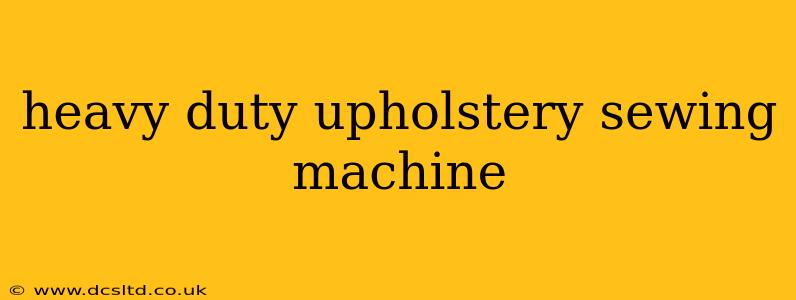Choosing the right sewing machine for upholstery projects can feel overwhelming. The sheer variety of models available, each boasting different features and capabilities, can leave even experienced sewers feeling lost. This guide dives deep into the world of heavy-duty upholstery sewing machines, helping you navigate the options and find the perfect machine for your needs. Whether you're a professional upholsterer or a passionate DIY enthusiast, understanding the key features and considerations will ensure you invest wisely.
What Makes a Sewing Machine "Heavy Duty"?
A heavy-duty sewing machine isn't just a marketing term; it signifies a machine built to handle the rigors of demanding tasks. Key characteristics of a heavy-duty machine include:
- Powerful Motor: These machines boast a robust motor capable of powering through thick fabrics, multiple layers, and tough materials like leather and vinyl. Weak motors often stall or overheat when faced with such challenges.
- Strong Internal Components: Heavy-duty machines are built with reinforced internal parts, including the needle bar, feed dogs, and bobbin case, to withstand the stress of consistent high-speed sewing and thick materials.
- High-Speed Sewing: The ability to sew at higher speeds significantly increases efficiency, particularly beneficial for large upholstery projects.
- Extra-High Needle Penetration: This allows the machine to easily pierce thick layers of fabric, preventing skipped stitches and broken needles.
- Durable Construction: These machines are typically made with heavier-gauge metal, enhancing their longevity and resistance to wear and tear.
What are the Best Features for Upholstery?
Beyond the general "heavy-duty" label, specific features are essential for successful upholstery projects:
- Walking Foot: A walking foot, also known as a feed dog, ensures even feeding of thick fabrics, preventing puckering and uneven stitches, a common problem with upholstery work.
- Adjustable Presser Foot Pressure: The ability to adjust presser foot pressure is vital for working with a variety of materials, from delicate fabrics to thick leathers. Higher pressure prevents slippage on thicker materials.
- High Stitch Length: A wide range of stitch lengths is needed for various upholstery techniques and materials. Longer stitch lengths are often preferred for strength and durability.
- Reverse Stitch Function: A dependable reverse stitch function is essential for securing stitch beginnings and ends, adding crucial strength to your seams.
- Multiple Stitch Options: While a straight stitch is the most common for upholstery, additional stitch options can enhance your projects and add creative flexibility.
What Types of Needles are Needed for Upholstery?
The type of needle you use is critical for success. Using the wrong needle can lead to broken needles, skipped stitches, and damaged fabric. Upholstery typically requires heavy-duty needles designed for thick materials, often with a thicker shaft and stronger point. Always check your machine's manual for the correct needle size and type.
Can I Use a Regular Sewing Machine for Upholstery?
While you could attempt upholstery with a regular sewing machine, it's highly discouraged. The machine is likely to overheat, the motor will struggle, and you'll probably end up with frustratingly inconsistent stitching and potentially broken needles. Investing in a heavy-duty machine is the best approach for quality results and a smoother, more efficient workflow.
How Much Should I Expect to Spend on a Heavy Duty Upholstery Sewing Machine?
The price range for heavy-duty upholstery sewing machines varies considerably. Entry-level models can start around $500, while professional-grade machines can cost several thousand dollars. Your budget and the frequency of your upholstery projects will dictate the appropriate price point.
How Do I Maintain My Heavy Duty Upholstery Sewing Machine?
Proper maintenance is crucial for extending the life of your machine. This includes regular cleaning, oiling, and replacing worn parts as needed. Refer to your machine's manual for specific maintenance instructions. Consistent maintenance will prevent costly repairs and ensure your machine continues to operate smoothly.
This guide provides a solid foundation for understanding heavy-duty upholstery sewing machines. Remember to research specific models based on your needs and budget. Happy sewing!
